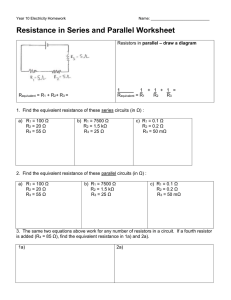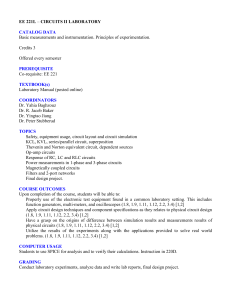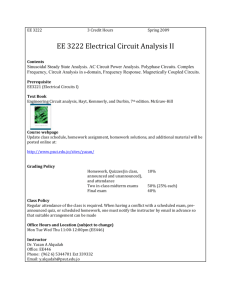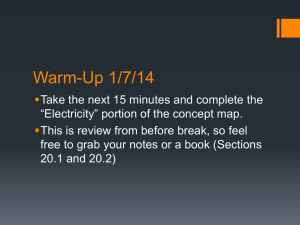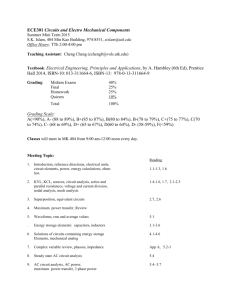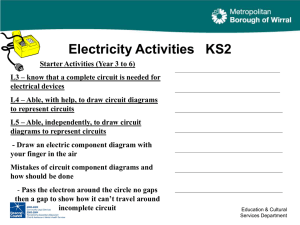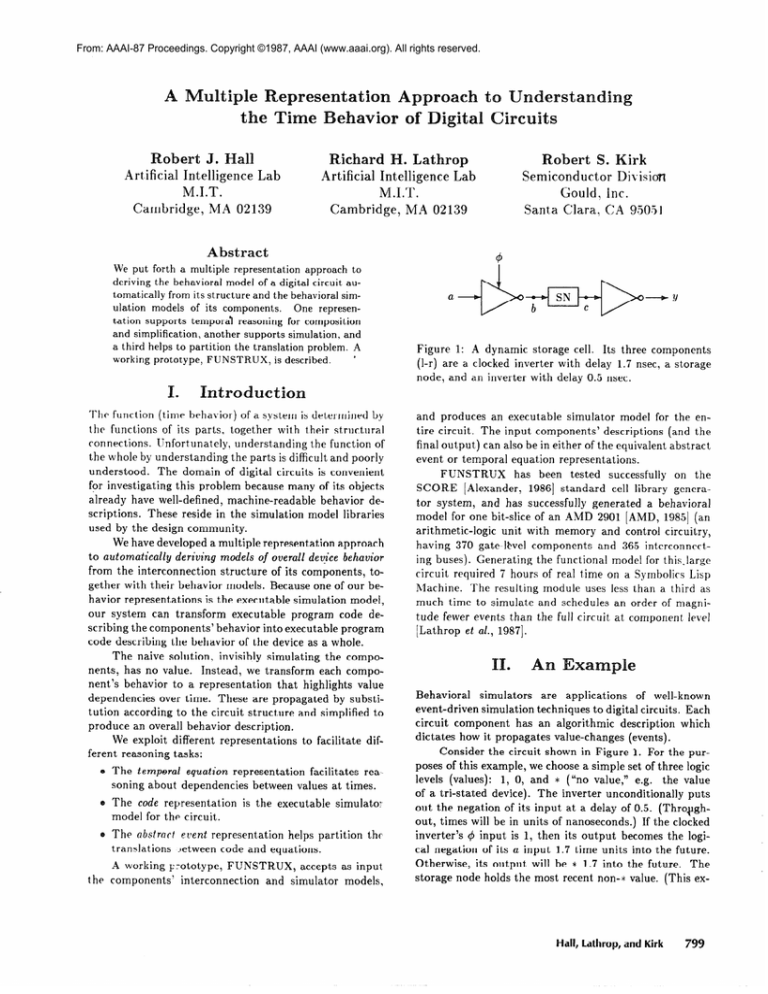
From: AAAI-87 Proceedings. Copyright ©1987, AAAI (www.aaai.org). All rights reserved.
sesentation
oath to Understan
A
i&al
Robert J. Hall
Artificial
Intelligence
Lab
M.I.T.
Cambridge,
MA 02139
Circuits
Robert S. Kirk
Semiconductor
Division
Gould, Inc.
Santa Clara. CA 950.51
Richard EL Lathrop
Artificial
Intelligence
Lab
M.I.T.
Cambridge,
MA 02139
Abstract
We put forth a multiple representation
approach to
deriving the behavioral model of a digital circuit automatically from its structure and the behavioral simulation models of its components.
One representation supports tempera) reasoning for composition
and simplification,
another supports simulation, and
a third helps to partition the translation problem. A
’
working prototype, FUNSTRUX, is described.
a
Figure
(l-r)
node,
(time
the functions
behavior)
of a system
of its parts,
together
connections.
Unfortunately,
the whole by understanding
understood.
storage
inverter
cell.
Its three components
with delay
1.7 nsec, a storage
and an inverter with delay 0.5 nsec.
Introduction
I.
‘I’hc function
A dynamic
1:
are a clocked
The
their
by
structural
understanding
the function of
the parts is difficult and poorly
domain
for investigating
is determined
with
of digital
this problem
circuits
because
and produces
simulator
model
for the en-
The input components’
final output)
can also be in either of the equivalent
event or temporal
is convenient
many of its objects
an executable
tire circuit.
equation
FUNSTRUX
SCORE
has
[Alexander,
descriptions
(and the
abstract,
representations.
been
tested
successfully
19861 standard
cell
library
on
the
genera-
already have well-defined,
machine-readable
behavior descriptions.
These reside in the simulation model libraries
tor system, and has successfully
generated a behavioral
model for one bit-slice of an AMD 2901 [AMD, 19851 (an
used by the design community.
arithmetic-logic
We have developed
a multiple
deriving
to automatically
representation
of overall devjce
models
from the interconnection
structure
gether with their behavior models.
havior
representations
our system
scribing
code
can
the components’
describing
The
nents,
naive
the behavior
solution,
has no value.
simulation
executable
behavior
behavior
of its components,
toBecause one of our be-
is the executable
transform
approach
program
into executable
model,
code
de-
program
an overall
We exploit
Instead,
ferent reasoning
o The
simulating
we transform
B The
model
Q The
about
dif-
between
facilitates
rea-
values at times.
is the executable
simulato:
for the circuit.
absirocl
translations
A working
the
to facilitate
representation
dependencies
code representation
components’
event
representation
helps partition
the
.ietween code and equations.
r:ototype,
Machine.
the functional
7 hours
of real time
The resulting
time to simulate
and control
and
module
model
for this.large
on a Symbolics
Lisp
uses less than a third as
and schedules
tude fewer events than the full circuit
[Lathrop
circuitry,
365 interconnect-
an order of magniat component
level
et al., 19871.
the compo-
description.
representations
equation
Generating
required
memory
components
each compo-
tasks:
temporal
soning
behavior
different
ing buses).
circuit
much
unit with
370 gate-level
of the device as a whole.
invisibly
nent’s behavior to a representation
that highlights value
dependencies
over time. These are propagated
by substitution according to the circuit structure and simplified to
produce
having
FUNSTRUX,
interconnection
and
Behavioral
simulators
dictates
how it propagates
Consider
as input
simulator
models,
applications
of
well-known
the circuit
value-changes
shown
(events).
in Figure
1. For the pur-
poses of this example, we choose a simple set of three logic
levels (values) : 1, 0, and * (“no value,” e.g. the value
The inverter unconditionally
puts
of a tri-stated device).
out the negation of its input at a delay of 0.5. (Thropghout, times will be in units of nanoseconds.)
If the clocked
inverter’s
4 input
cal negation
accepts
are
event-driven simulation techniques to digital circuits. Each
circuit component
has an algorithmic
description
which
is 1, then its output
of its a input
becomes
1.7 time units
the logi-
into the future.
Otherwise,
its output will be * 1.7 into the future.
The
storage node holds the most recent non-* value. (This ex-
Hall, Lathmop, and Kirk
799
(defun
storage-node-fen
“b
input,
(let*
(self
((b-value
(if
(#?
(read-bus
(put-my-state
ACT
simplify
conv
circuit
circuit
4
events
I
coding
conventions;
driven
core.
back)
into
stracts
‘(bit)
b-value))
‘(bit)))))
Dif-
have differing semantics
however,
they share a common
event representation
of translating
from
code
(1) a simulator-dependent
from the particular
abstract
>
REPRESENTATION.
simulators
The abstract
the problem
equation
I
’ (bit)))
‘(bit)
self
EVENTS
ferent event-driven
conv
circuit
code
I
self
c self
(get-my-state
+
b
* b-value)
(drive-bus
substitute
b c>
c output”
partitions
to equations
segment
semantics
(and
which
ab-
of the simulator
and (2) a simulator-independent
events,
and
event-
into
segment
which translates
Figure
ule.
21 The FUNSTRUX
Representation
of a circuit
into another.
form various
system
conversion
change
Substitute/simplify
one view
modules
minor
et al.. 1987
in FUNSTRUX’
code
and
since
that paper.)
FUNSTRUX
produces
the following
code
from
this
example.
(Only the code for the y output is shown here.)
(defun
dynamic-storage-cell-fen
(self
a y phi)
(depends-on
‘(a phi)
‘0
(if
(logone
(read-bus
(put-my-state
(read-bus
(depends-on
’0
(drive-bus
a
says that
y self
“when
either
schedule
astate changes,
an event 2.2 later to drive y to the value of astate.”
omits
the double
the storage
node changing
negation
This
and the details
of
event representation
from the code above,
inputs
((cv
(b)
This represents
The first event
node,
: (b)
ep
( (cv(bstate)
(schedule
sents the memory
of the storage
is
<#? * b))
bstcLte at 0 equal-to
ep T)
c at 0 equal-to
a cell with one input,
of the storage
clause indicates
b))
b,tste>))
b. bstate repre-
node, and c is the output.
that when either the value
the predicate
changes
rescentations
uled at the same time which sets bstate to the value of b.
(Note that in the example b is not * only when the clocked
system’s
inverter
multiple
representation
scheme
ioral simulation
[Lathrop and Kirk, 1985], netlist manipulation [Lathrop ant >Tirk. 19861, and parameterized
cell
generators [Alexander.
19861. STAR’s LISP-based
behavSIM?.!ER,
is our target.
SIMULATOR
CODE
REPRESENTATHON.
code representation
is described
in [Lathrop
model
for the storage
is driving.)
a change
19851) is shown in Figure 2. It runs as one
of the STAR design system [Kirk et al., 19871
Expert Systems
similar to our enable-
(ep) .
value.
and continues an investigation into function, structure, and
their relationships.
The STAR system integrates behav-
800
and the
if either the
and the predicate
ConvePsions
19851. The SIMMER
(ep)
of b changes
e
ioral simulator,
19791 used a notation
jMeinen,
if 4 is
astate to
(see [Rich,
component
true.
ment predicate
event:
value of a. Whenever
predicate
The event occurs
enablement predicate becomes true or one of the changingvariables changes value while the enablement predicate is
2.2)))
an event at the same time to change
description
list.
(schedule
1, schedule
The FUNSTRUX
the enablement
(cv)
event:
a or 4 changes,
consists of the event
to be scheduled
for
delay, and the symbolic
expression
The event condition
predicate
con-
changing-variable
(Event-cell
‘(a-state))
descriptions.
sists of two parts,
‘(bit)
self
the relative
new value.
produced
self
‘(a-state)
‘(bit))
0.0)))
behavior
event description
the variable
predicate,
The abstract
‘(bit)))
the current
*
change,
for the
’ (a-state)
(get-my-state
This
phi
for different
An abstract
condition
from [Lathrop
improvements
tion
the system
per-
sorts of simplification.
ample has been simplified
reflects
has two sorts of mod-
modules
from the event representation
to the equaThis will make it easier to re-target
representation.
and
node is
The
Kirk,
[#? * b] is true,
The
second
event
of c, but since the enablement
happens
or when
from false to true, an event is sched-
clause
schedules
predicate
is T it
on any change of bstate.
BORAL
EQUATIONS
REPRESENTATHON.
One key insight in our approach is that one needs a behavior representation
with locality of reference among circuit
values at given times. This means that the time points relevant to the computation
of a vai?ue must be explicit, and
that circuit value dependencie:
Zould be explicit and local
to uses of the circuit values. For example, applica‘ive
programs have locality of referericsY, while programs which set
and use global variables at widely separated places do not.
[Davis,
19831 has emphasized
reasoning
about
the behavior
the importance
of circuits.
of locality
for
Tinlelines
ues.
are mappings
We view
[Kelly
circuits
and Steinberg,
their time domain
A circuit
or earlier
tors,
-
and +
second
t is expressed
times.
argument
was true.”
Thus,
u, prior
of its inputs
time opera-
must be a non-negative
to “the most
{$
[Pu]
(or equal)
at the
values at earlier times.
recent
time
inputs and initialization,
denotes the unique solution
simultaneous
The abstract
equations.
(and the simulator
erational
The
stract
events representation
disallowed.
Proving
MPOSITION.
opera-
formalism
for representing
but did not automate
and did not relate the representation
We represent
computation
prefix to infix notation
temporal
equations
format.
for t,he example’s
4 b(u)]
REPRESENTATION
conversion
CONVERSIONS.
algorithms
b Code t
Abstract
ecuted
to associate
each symbol
with a formula
computes
its value under the appropriate
Unknown
forms
according
to the semantics
perform
are treated
side-effects
variable)
Events
between
so the value
event expression
By constructing
variable’s
value
a predicate
e Abstract
-+ Abstract
Events
+
be generated
indicates
when
we are able to reason
“State
have triggered.
objects”
Each
variable
which produce
constructs
representation
mantics
for the circuit
as a notation
structure.
for a denotational
A circuit,
together
sewith
complexity,
hence,
the combi-
simplification
substitution
expression
size.
SIMPLIFIERS.
supports
transformations,
is
and simpliOur system’s
simple pattern-
similar to those used by
[Darlington,
19811for program
optimization.
The rules in
FUNSTRUX
terminating
are tailored to simplification.
rule set, so the system applies
They form a
them until no
Experience
has shown that we do not
need to search different application
One simplifier
applicable
(#?
above
is
* (if p re d’
zca t e value *))
(AND
We have implemented
proximately
orders.
to the equation
simplifies
-
using
scheme must at some point answer the question of semantic equivalence of different representations.
We view the
;else
local representation
action expression
can then
SElW4NTIC
CONNECTIONS
BETWEEN
THE
REPW ESENTATIONS.
A
multiple
representation
equation
PATTERN-ACTION
syntactically
can be re-
the effect of each event.
*h
to reduce intermediate
may be
port or a state object,
Language
;test
;then
interleaves
more are applicable.
a
1 d(v-1.7))
is much worse;
delay the values of the inputs.
Code.
structure.
change
most recently.
Events.
solved into either an I/O
the circuit
fication
t is the value
last changed,
to conditionally
FUNSTRUX
at time
the last time an event would
e Equations
needed.
occurred
which
fthen
;else
7 a(z.- 1.7)
of even moderate
which
a global
A value doesn’t
On circuits
explosion
functions
or setting
;test
-1.7)
*) ; final else clause
natorial
correctly.
--+ Equations.
events,
of whichever
created
* (if (=?
t -0.5)
ex-
of pure LISP. Forms which
(e.g., reading
are not modeled
o Abstract
about
‘f?
1 A({$
conditions.
as “black-box”
1 @(u-1.7))
1 -O.S}
t})
The code is symbolically
Events.
example:
[#? * (if (=?
- 1.7))
et al., 19871. Here are the key ideas.
in [Lathrop
on which b depends
{)I
The reprein more detail
are treated
of
by replac-
1 a(u-1.7)
;else
[#?
1 d({Z
sub-
locality
b was used.
y(t) = 1 c(t-0.5)
Inverter:
sentation
The
maintains
the variables
Here is the fully substituted
y(t) = 1 (if (=?
of the compoto algebraic
to b(t) is expanded
everywhere
;test
;then
1.7)
*>
c(t) = b({-s
This process
when a reference
explicitly
amounts
are
b(t) = (if (=? I 4(t-1.7))
Node:
ap-
(We have
components
- upStorage
appear
here for readability.)
of equations.
reference:
the behaviors
representation
ing it with b’s definition,
the reasoning
to simulation.
LISP-like
converted
Inverter:
and rea-
on values as functional
in a side-effects-free
Clocked
loops are
and abstract
is an open problem.
Composing
stitution
plication
of the code
t} refers to the most recent
t, such that the predicate P
to
a discrete
circuits,
op-
constant.
et al., 19831; however, they also work with
lAmblard et al., 19851 proposed
time domain.
about
as long as zero-delay
equivalence
events representations
nents in equation
soning
with event-based
a predicate
at u. This is similar to the left-arrow
applicative
code) are endowed
]Hall, 19871 shows that our equation
is equivalent to an essentially similar ab-
tor of [Schwartz
a similar
to the
event representation
semantics.
representation
in a tempo-
We use two primitive
to -
reference
was satisfied
function
for expressing
-+= allows
time,
at time
as an applicative
same
into val-
was discrete.
output
ral equation
of the real numbers
as mappings between
timelines.
19821 used a timeline notion, but
predicate
to
(#?
a symbolic
* value))
simplifier
50-75 rules of this type.
the size of tl-a expressions
by about
which uses ap-
It typically
90%.
Syntactic
reduces
lbcal-
ity is cruciai LO the efficiency of this technique, as hunting
all over a non-local representation
would slow down the
pattern
matchers.
less efficient,
Furthermore,
as relatively
the action
parts would be
major surgery would be required.
Hall, Lathrop, and Kirk
801
plied
Simplifiers free of hime operators
could also be apto the abstract event and/or code representations.
the same can not be said for pattern-action
which involves time relationships.
However,
plification
REASONING
Locality
ABOUT
of reference
is also important.
TIME
among
{Z
{g
For example,
of variables
[predicate
(u-y)]
simplifies
-
{$
this is applicable
t}-7
(t-y)}
to understanding
y from the most recent time u 5
t such that
time u 5
t - y that predicate
Another
recent
is true.
all of the system’s
pattern-action
simplifiers
we get
a({-Z
- .
1
crucial
[=?
[=? 14(u)]
14(u)]
I=?
I=? 14(u)]
14(u)]
(t-2.2)}))
; test
(t-2.2)})
feature of the locality
property
(2, (i-2.2),
of propositional
reasoning
about
points.
It is an open question
will need to reason about any other
a propositional
This is needed in order to incorporate
ground
knowledge,
such
we have not
that it will.
reasoner
about the truth of predicates
to sup-
at time points.
some types of back-
as “if a value
is known
to be 1
at a time, it is not also 0 at that time;” to handle certain
kinds of simplifying assumptions
[Feldman and Rich, 19861;
and to support simplifications
based on logical conditions
implied
by the context
of an expression,
for example,
icates which are true due to nesting within
In the example,
(=?
can not be simplified
1 c$({-&
to TRUE,
pred-
a conditional.
[=? 1 4(u)]
because
(t-2.2)}))
it could
be that
4 has never been 1 prior to t - 2.2. Frequently, however,
we wish to consider only the normal-case
behavior of the
circuit,
in which 4 will have been 1
1 prior to
under consideration.
assumption
We can communicate
to our system
iqf ,-- --20).(-z
The system
cation
reduces
this axiom
to a proposition
t - 2.2 for any t
this simplifying
by the axiom
[=? 1 qqu)!
quantifi-
for each time point in the equation
and concludes,
through propositional
reasoning, that thpredicate is true. With the other simplifiers, this product;
y(t) = a({$
802
Expert Systems
[=? 14(u)]
(t-2.2)})
the program
models
their structural
approach
circuits.
to accept
To
program
of the circuit
components,
connections,
and produce
code for the circuit
model
as a whole.
8 The equation-based
representation
makes easier several forms of reasoning about the time behavior of
circuits.
of
Locality
representation
code-based
is the crucial
reference
makes
simulation
effi-
cient.
The abstract
translation
Unknown
event-based
problem
forms
black-boxes
The
system’s
local
partitions
the
and equations.
code
are treated
to the semantics
representations
as
of pure LISP.
support
efficient
simplification.
The finitely-many
plicit,
code
in the program
according
pattern-action
representation
between
allowing
relevant
time
propositional
points
reasoning
are made exfor time-based
simplification.
This
work
step toward
in the class
restrictions
is preliminary
and represents only a first
FUIVSTRUX
is limited
our goal. Currently,
of circuits to which it can be applied.
The
are (1) busses can connect only to blocks (not
(2) b usses change state only when driven
to each other),
by a block,
ticular,
and (3) zero-delay
this disallows
loops are disallowed
zero-delay
bidirectional
Here are a few issues for further
e There
realm
are several
of digital
interesting
circuits
tend our representation
sign optimization
to
research.
reasoning
which
scheme.
[Steinberg
(in par-
elements).
we
tasks
in the
hope
to ex-
Some examples:
and Mitchell,
de-
19841, trou-
bleshooting [Davis and Shrobe, 19831, testing [Shirley,
19861, and learning about design [Hall, 19861. Each of
these tasks requires its own representations.
t} > -co
from a universal
with
The
problem
of time
We have implemented
port reasoning
for the functional
together
of digital
this is the first system
is that
and {g
[=? 1 b(u)]
(t-2.2)}),
plus -00.
Note that we
have reduced the problem from reasoning about Vt and 3 to
times than these for simplification;
however,
yet come across any examples which indicate
code
representation
propert,y of this representation.
mentioned
in the equation
our knowledge,
our multiple
the time behavior
digital
the ones explicitly
our system
2.
srk
; then
the set (relative to 2) of time points
t.o the output value.
These are just
whether
astnte))
an
; else
it exposes exactly
which are relevant
the much easier
a finite number
a>>
this to the code in Section
Conchsions
We have explained
[predicate(u)!
Iprediellle’
(u)j
y(t)
1 q5
4 ((2
y(t) = (if (=? 1
ep T)
y at 2.2 equal-to
then converts
this
4)
ep(=?
1 4))
astrrte at 0.0 equal-to
: ( (cv(a,tate)
(schedule
The system
v.
is true at u - y, is the same as the most
Applying
inputs:(a
event
Converting
produces
to
predicate
to the example,
for the example.
event:((cv(a
4)
(schedule
RELATIONSHIPS.
time relationships
equation
events, the system
(Event-cell
First, there are several useful time-based
pattern-action
simplifiers.
to the equation above:
Subtracting
sim-
as the simplified
to abstract
e There are several ways the system
it currently
could be improved:
does not find closed forms for the recursion
equations which result from feedback; ir could allocate
state objects for simulation
better than it currently
does; it could recognize low-level implementations
higher level functions, such as integer +.
of
IHall, 19861 Robert
o The code
ganized
which
is output
by FUNSTRUX
is not or-
e It may be useful to incorporate
of VLSI
[Lathrop
and Kirk,
19861.
o What
constraints
lator
in order
must be met by a particular
that the abstract
be able to capture
simu-
event representation
an equivalent
would like to acknowledge
with Mark Alexander,
Rivest,
support
Walter
uate Fellowship.
Personal
helpful
discussions
Chuck Rich, Ron
for the second
author
by an IBM Graduate
Fellowship, and durstages of this research by an NSF Gradu-
ate Fellowship.
jointly
at the
Gould Semiconductors
CAD Research Laboratory
the %IJT Artificial Intelligence Laboratory.
Support
and at
for the
~11’1‘ .4rt,ificial
is pro-
vided
This
paper
Intelligence
was prepared
Laboratory’s
research
in part by the Office of Naval Research
tract
[Kelly and Steinberg,
under con-
Richard
grated
[Lathrop
Robert
19861 Mark
the IEEE
1986
(CICC-86),
[Amblard
Custom
IEEE,
Describing
havior
Circuits
fear11 \‘LSl
P. Caspi,
by means of time functions.
ware
Description
IFIP,
1985.
Bipolar
terface,
AM2900
Devices,
1985.
Family
and
their
Microprocessor
19811 J. Darlington.
system.
pro-
Artificial
19831 Randall
Davis.
Diagnosis
via causal
reason-
ing: paths of interaction
and the locality principle.
In Proceedings
of the Third National Conference
on
Intelligence
and Shrobe,
Shrobe.
(AAAI-83),
19831 Randall
Representing
tal hardware.
‘Feldman
AAAI,
Davis
structure
Con:puter,
and Rich,
and behavior
16(10), October
19+6] Yishai
1983.
and
Feldman
Howard
of digi-
1983..
and
Charles
Rich.
Reasoning
with simplifying
assumptions:
a
methodology
and example. In Proceedings of the Fifth
National
Conferer
86), AAAI,
in VLSI
:e on Artijicial
Intelligence
IEEE,
1987.
Lathrop
H.
and
object-oriented
mixed-,
In Proceedings
on Artificial
II. Lathrop.
Functional
simulation
Design
transfer
ln1elll-
Robert
J. Hall,
abstraction
models.
Automation
from
In Proceedings
IEEE,
Conference,
Formal semantic
language
construction.
ware Description
[Rich,
for reasoning
The
about
on
IEEE,
layered
Joint
4th
1979.
of a
In Proceedings
Conference
on Arti-
1985.
Vogt,
L.
Schwartz,
and D.A.
Logic for Higher-Level
Melliar-
An Interval
Reasoning.
ContracNational
Aeronautics
And Space Administration,
H. Shirley.
M.
NASl-17067,
Temporal
Number
I’.
Plaisted.
Contract
19861 Mark
of
Bard-
architecture
tors Report:
[Shirley,
of the
Computer
programs.
International
et al., 19831 R.
F.H.
description
and mechanized
In Proceedings
Languages,
Intelligence,
[Schwartz
elements
Symposium
19851 Ch ar 1es Rich.
ficial
An experimental
and synthesis
enInte-
1986.
Richard
International
Logic and In-
16, 1981.
Intelligence,
Artificial
IEEE
system
Micro
and
Custom
(CICC-871,
.4AAI,
19791 P. Meinen.
Applications,
Advanced
Databook.
of the IEEE
manipulation.
S. Kirk.
24th
Smith,
gram transformation
iDavis
Robert
simulator
of
Hard-
structure
of the Ninth
19851 AMD.
[Darlington,
on Computer
J. Hall,
development
1987.
be-
In Proceedings
Symposium
Languages
circuits
cell
simulation system. In Proceedings of
Automation
Conference,
IEEE, 1985.
ei al., 1987,
[Meinen,
and N. Halb-
about
SCORE
An extensible
(.4AA4 I-86),
of the
of
Conference
1982.
Robert
of the Fifth ,1’aiiorlal Corlfererlce
register
and reasoning
the 7th International
[Davis,
Integrated
S. Kirk.
on Ar-
Robert
reasoning
In Proceedings
May 1986.
et al., 19851 P. Amblard,
wachs.
[AMD,
A spatial
In
Conference
AAAJ,
(AAAI-82),
Conference
S. Kirk.
structure
generation.
cir-
Lathrop
and Kirk. 1986’ Richard
and
H.
A system M hich uses examples to
S. Kirk.
iJ,athrop
and
Alexander.
to cell layout
analyzing
19851 Richard
mode functional
the 22nd Design
ilathrop
eferences
digital
and specifications.
National
In Proceedings
Circuits
gence
approach
system:
behaviors
H. Lathrop.
and Kirk,
Simulation
1987.
of the Second
vironment.
In Proceedings
on Applied
19821 Van E. Kelly and Louis Stein-
CRITTER
[Kirk et al., 19871 Robert
X00014-80-C-0505.
[Alexander,
The
tificial Intelligence
Hamscher,
support
IASTED,
and Modelling,
1986.
denotational
simulation.
Conference
Conference
AAAI,
A fully abstract
for event-based
Fifteenth
Proceedings
Brian Williams,
and Patrick Winston.
Personal
for the first author was furnished by an NSF Grad-
was furnished
ing the early
of the
by failing to ex-
(AA,4I-86),
J. Hall.
cuits by propagating
cknowledgments
The authors
semantics
berg.
meaning?
Hall. Learning
of the Fifth National
Intelligence
]Hall, 19871 Robert
work on pattern-action
structure
Joseph
In Proceedings
on Artificial
for readability.
simplification
plain.
1983.
Generating
tests by ex-
ploiting designed behavior. In Proceedings of the Fifth
National Conference
on Artificial Intelltigence (AAAI86), AAAI,
ISteinberg
1986.
and Mitchell,
19841 Louis
1.
Steinberg
and
Tom 11. Mitchell.
A knorvledge based approach to
VLSI CAD: the REDESJ:~;N system.
In Proceedings
of the
2lsf
Design
A v/c. :zation
Conference,
IEEE,
1984.
(AAAI-
1986.
Hall, Lathrop, and Kirk
803

